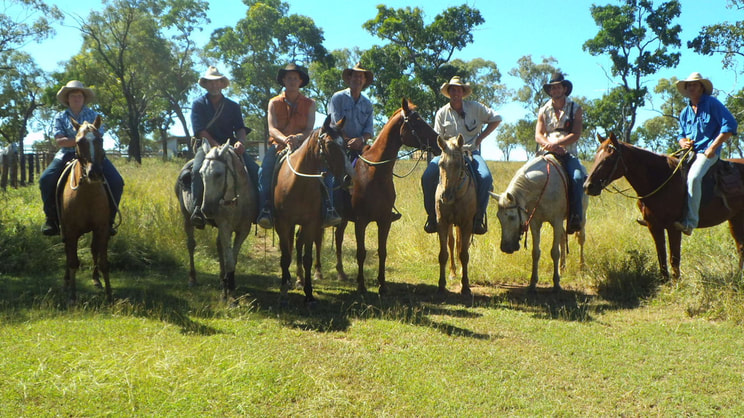Mustering cattle on Karma Waters Station by Jennifer Eliot
Cattle
Cattle on Karma Waters are Braham Cross and we run a herd of around 1600 mixed cattle. We have two rounds of mustering undertaken annually in May and September and is carried out with 6 to 8 men on horseback and helicopter. Fencing the country into large paddocks has cut back on mustering costs, and has improved the quality of cattle by excluding feral bulls. All stock are inoculated for botulism and weaners are taken off during both rounds.
We have developed the Mitchell country into 5 main paddocks for breeders and 8 smaller paddocks for weaners, finishing steers, aged cows and holding our bulls which we take out in September and return to the breeders in early February. This is to eliminate winter calving and maximise calving percentages. This practice has also minimised death rates in the breeders by ensuring calves are dropping at the right time of the year. During their time out of the herd the bulls are kept in good stylo country to maintain body weight.
Our breeders alternate on a year on year off spelling regime which allows the country to regenerate and maintain our stylos and 3 p grasses.
Supplementary feeding is done on a year round basis and through the results of monthly dung tests for 4 years has identified the requirement to feed phosphorus all year as protein levels are sufficient to allow for weight gains.
We have developed the Mitchell country into 5 main paddocks for breeders and 8 smaller paddocks for weaners, finishing steers, aged cows and holding our bulls which we take out in September and return to the breeders in early February. This is to eliminate winter calving and maximise calving percentages. This practice has also minimised death rates in the breeders by ensuring calves are dropping at the right time of the year. During their time out of the herd the bulls are kept in good stylo country to maintain body weight.
Our breeders alternate on a year on year off spelling regime which allows the country to regenerate and maintain our stylos and 3 p grasses.
Supplementary feeding is done on a year round basis and through the results of monthly dung tests for 4 years has identified the requirement to feed phosphorus all year as protein levels are sufficient to allow for weight gains.
Animal Welfare
The Livestock Production Assurance (LPA) program is the Australian livestock industry's on-farm assurance program covering food safety, animal welfare and biosecurity. It provides evidence of livestock history and on-farm practices when transferring livestock through the value chain.
Karma Waters has had a site audit and Certificate of Completion with the components of the assessment being:
Animal Welfare: Australia's red meat customers and consumers, both domestically and overseas, seek reassurance that livestock are cared for humanely and ethically. Producers must be able to demonstrate they care for their animals in line with the Australian Animal Welfare Standards and Guidelines for cattle, sheep and goats.
Risk Assessment: to minimize livestock exposure to contaminated sites and physical contaminants on the property
Stock Feed ,Fodder Crops, Grain and Pasture Treatments: not exposed to contaminated food and safe livestock feed practices and livestock aren't feed restricted animal material.
Preparation for Dispatch of Livestock: livestock must not be stressed, contaminated or injured during assembly for transport.
Livestock transaction and movements: record livestock movements so if food safety occurs the livestock are fully traceable.
Biosecurity: on-farm biosecurity systems minimises both the risk of infectious diseases being introduced to livestock production properties.
Livestock: livestock arriving on property inspected, identified, recorded and period of quarantine before leaving yards.
Karma Waters has had a site audit and Certificate of Completion with the components of the assessment being:
Animal Welfare: Australia's red meat customers and consumers, both domestically and overseas, seek reassurance that livestock are cared for humanely and ethically. Producers must be able to demonstrate they care for their animals in line with the Australian Animal Welfare Standards and Guidelines for cattle, sheep and goats.
Risk Assessment: to minimize livestock exposure to contaminated sites and physical contaminants on the property
Stock Feed ,Fodder Crops, Grain and Pasture Treatments: not exposed to contaminated food and safe livestock feed practices and livestock aren't feed restricted animal material.
Preparation for Dispatch of Livestock: livestock must not be stressed, contaminated or injured during assembly for transport.
Livestock transaction and movements: record livestock movements so if food safety occurs the livestock are fully traceable.
Biosecurity: on-farm biosecurity systems minimises both the risk of infectious diseases being introduced to livestock production properties.
Livestock: livestock arriving on property inspected, identified, recorded and period of quarantine before leaving yards.
- Feed: when purchase stockfeed and fodder the suppliers provides a Commodity Vendor Declaration.
- Water: quantity and quality of water of suitable for type of livestock under production.
- Production Practices: livestock is monitored, identified and animal health management practices adhered to.
- Pest and Weeds: identified, monitored, managed and recorded.
- Out going Products: all livestock leaving property is identified with the NLIS standards.
- Train-Plan-Record: all personnel responsibility for management and husbandry understand their role of implemented of biosecurity practices on-farm.
- Documentation and record keeping: record animal activities and treatments
